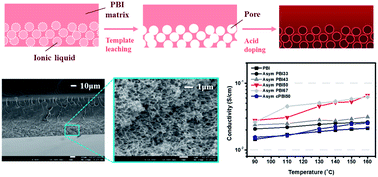A novel asymmetric polybenzimidazole membrane for high temperature proton exchange membrane fuel cells
Abstract
A novel asymmetric polybenzimidazole (PBI) membrane used for high temperature proton exchange membrane fuel cells has been successfully fabricated by a soft-template method using the ionic liquid 1-ethyl-3-methylimidazolium bis(trifluoromethylsulfonyl)imide ([EMIM][TFSI]) as the porogen. Typically, the asymmetric PBI membrane exhibits a double-layer structure comprising a dense layer and a porous layer with a distinguishable boundary. The morphology and asymmetry of the porous structure have been characterized by SEM micrographs. The density difference between the polymer matrix and the porogen can be considered as the driving force for developing the asymmetrical structure. Phosphoric acid-doped asymmetric PBI with a high porosity exhibited considerably enhanced doping levels and proton conductivity. For example, a doping level of up to 23.6 and a proton conductivity as high as 6.26 × 10−2 S cm−1 were achieved. Moreover, the crosslinking modification of asymmetric PBIs had beneficial effects on the mechanical strength and oxidative stability, which were investigated. We have also demonstrated the fuel cell performance of a membrane electrode assembly (MEA) based on the asymmetric PBI at elevated temperatures under anhydrous conditions in the present work.


 Please wait while we load your content...
Please wait while we load your content...